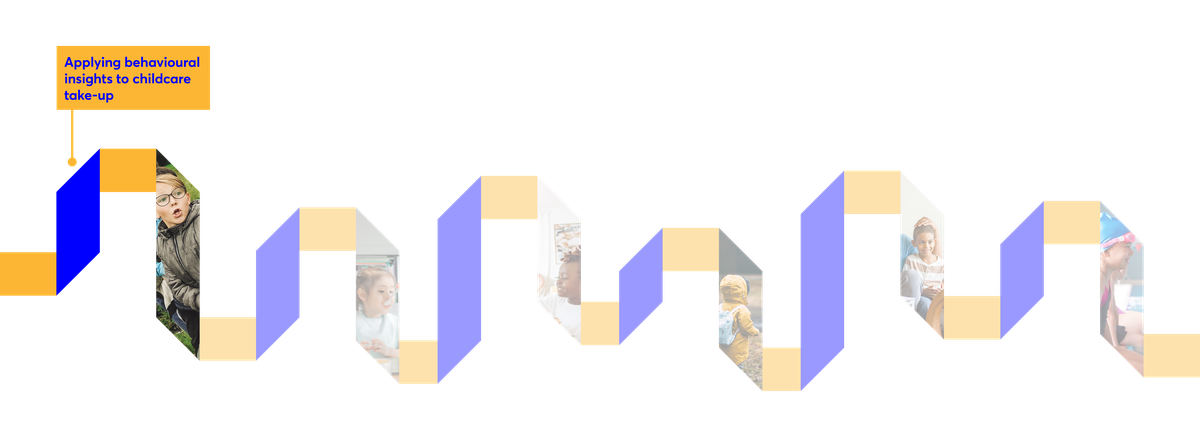Choosing whether to use formal childcare is a big decision for any parent. The way an offer is presented and advertised can make a big difference. And with take-up of the two year-old free childcare offer at just 62% in England in 2021, there is lots of scope for local authorities to boost the number of parents choosing to use it. This section provides ideas for how you can use the principles from behavioural science to do that, based on the Behavioural Insights Team and Nesta’s work with local authorities across the country.
An introduction to behavioural insights
A behavioural insights approach incorporates lessons from psychology and economics into policymaking.
Here’s a practical example. In 2017, the UK government introduced its flagship tax-free childcare scheme to replace childcare vouchers. Under the scheme, parents create a dedicated childcare account and receive a £2 government contribution for every £8 they pay in. In principle this is a generous subsidy, but in practice very few parents have taken advantage of it.
In 2018, the Behavioural Insights Team worked with HMRC to test out a series of different letters encouraging parents to take up the scheme. In one of the letters, a simple checklist of all the documents parents would need to apply was included, to reduce the hassle of the process ever so slightly. This increased the number of parents applying by 12%.
Applying behavioural insights to a two-year-old offer letter
In 2018, the Behavioural Insights Team worked with a local authority in England to increase the number of parents taking up the two-year-old offer. The focus was on the letter that they used to advertise the offer to parents.
Barriers to applying
We began by conducting interviews with parents to understand their perspectives on childcare in more depth. When we asked parents about their views on the letter, we heard about two main problems with it that deterred some parents from applying.
- Some thought the letter looked so formal that it could have been mistaken for a bill. This was off-putting, and prevented some parents from even wanting to open it.
- The letter was not very clear on what parents needed to do to apply, what information they would need and how long the process would take. The prospect that all of this could be a major hassle was enough to put some parents off.
What we did
With this feedback in mind, we set about re-designing the letter. We incorporated lots of lessons from behavioural science to produce an updated letter.
The main additions and changes we made were:
- A clear call to action. We put the main message (“Claim your free childcare today…”) at the very top of the letter and bolded it, so nobody could mistake the letter for a bill.
- Highlighting the exclusivity of the offer. We added a line emphasising that eligibility for the two-year-old offer is limited. This is based on a lesson from the world of advertising, that we tend to find products and services more attractive if we think supplies of them are scarce. A classic example is that sales of beans increased after a “max five per customer” sign was introduced.
- A social norms message. We told parents that they would be joining thousands of others in using the offer. Our aim here was to emphasise that using childcare was normal or even ubiquitous.
- A next steps checklist. We made it clear exactly what parents needed to do to apply, with a simple bullet pointed list to make the information easy to digest.
What happened when the letter was introduced?
We tested the updated letter in a randomised controlled trial against the ‘business as usual’ letter. The updated letter increased the application rate by about three percentage points, or by 9% in relative terms. If everyone in our study had received the updated letter, an extra 89 low-income parents would have received free childcare. This was not quite statistically significant (for an explainer of what we mean by this, see module 2) but it was a good starting point and warranted further testing.
The ‘golden ticket’ approach
Tweaks such as the changes to the two-year-old offer letter can be impactful. But they still assume a process in which parents receive an eligibility letter and then go through an application process. What about a system that takes out the parent application altogether?
That is what some local authorities across the country (including Newcastle, Dorset, Staffordshire, and Durham) have started to do with the golden ticket approach. These local authorities send parents an eligibility ticket rather than sending them a letter asking them to apply. All parents have to do is take the ticket to their chosen nursery or other childcare setting. This takes a good deal of the friction out of the process for parents.
The data so far suggests that the scheme is working well. Dorset County Council reported that take-up improved by six percentage points (from 81% in 2018 to 87% in 2019) when they introduced the scheme. More recently, some local authorities have scaled back the golden ticket because of new government data protection guidance that requires an eligibility check at some point in the process. Still, we think this is a really promising approach for increasing access to childcare.





